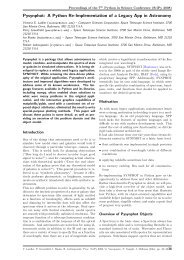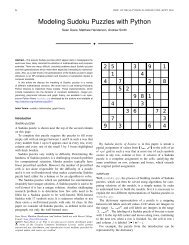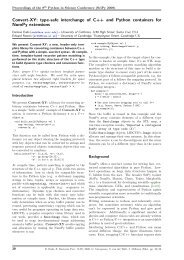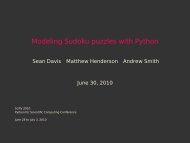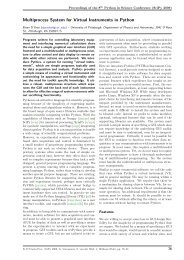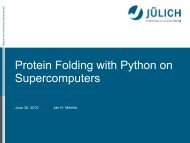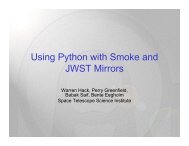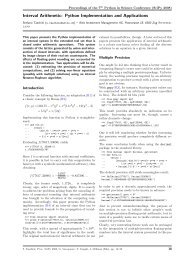Interval arithmetic - SciPy Conferences
Interval arithmetic - SciPy Conferences
Interval arithmetic - SciPy Conferences
Create successful ePaper yourself
Turn your PDF publications into a flip-book with our unique Google optimized e-Paper software.
s f.<br />
the <strong>arithmetic</strong> operations, represented<br />
pen that for any two arbitrary H, K ∈<br />
∉ L(IF). It is therefore necessary to<br />
closure of the interval <strong>arithmetic</strong> oper-<br />
+ K) H ⊖ K = I(H − K)<br />
× K) H ⊘ K = I(H ÷ K)<br />
effect of the float enclosure on the ariths<br />
is easily verifiable:<br />
10] / interval[3]<br />
33333333333333, 3.3333333333333339])<br />
e rounding mode of the processor’s<br />
nit ensures that <strong>arithmetic</strong> operations<br />
or down. In the Python implemend<br />
here, ctypes provides the low-level<br />
he standard C99 functions as declared<br />
falling back to the Microsoft C runtime<br />
e former are not present. A lambda extes<br />
the lazy evaluation that is required<br />
es in the interval.fpu module:<br />
rval import fpu<br />
lambda: 1.0/3.0)<br />
333331<br />
mbda: 1.0/3.0)<br />
333337<br />
common implementations of the C<br />
ematical library do not provide the<br />
olling how transcendetal functions are<br />
of this work therefore required implen<br />
binding for CRlibm, the Correctly<br />
ematical Library [R8].<br />
libm<br />
p_rd(1.0)<br />
90451<br />
N(ξ, η) = ξ − f(ξ)/f ′ (η) (4)<br />
Newton (2)<br />
If f(x) = 0 has more than one solutions inside [a, b],<br />
then, by Rolle’s theorem, the derivative must vanish<br />
somewhere in [a, b]. This in turn nullifies the denominator<br />
in equation (4), which causes ¯N({ξ}, [a, b]) to<br />
possibly return a lattice interval consisting of two disjoint<br />
components, in each of which the search can<br />
continue. The complete algorithm is implemented in<br />
Python as a method of the interval class:<br />
def newton(self, f, p, maxiter=10000):<br />
def step(x, i):<br />
return (x - f(x) / p(i)) & i<br />
def some(i):<br />
yield i.midpoint<br />
for x in i.extrema.components:<br />
yield x<br />
def branch(current):<br />
for n in xrange(maxiter):<br />
previous = current<br />
for anchor in some(current):<br />
current = step(anchor, current)<br />
if current != previous:<br />
break<br />
else:<br />
return current<br />
if not current:<br />
return current<br />
if len(current) > 1:<br />
return self.union(branch(c) for<br />
c in current.components)<br />
return current<br />
return self.union(branch(c) for<br />
c in self.components)<br />
In this code, step implements an interval extension<br />
of equation (4), with the additional intersection with<br />
the input interval to make sure that iterations are not<br />
widening the interval. Function some selects ξ: first<br />
the midpoint is tried, followed by the endpoints. The<br />
15



